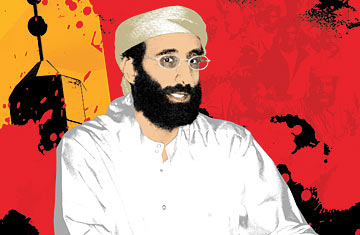
Anwar al-Awlaki
(2 of 3)
A Yemeni government scholarship allowed Anwar to return to the U.S.; in 1991 he enrolled in Colorado State University's civil-engineering program. Friends remember al-Awlaki as a low-key young man who lived modestly in a one-bedroom apartment and drove around Fort Collins in a beat-up old Buick. He prayed at the Islamic Center of Fort Collins but did not stand out as being especially religious and was not active in CSU's Muslim students association.
When he visited Afghanistan in 1993, a journey that fired thousands of young Muslim men with jihadist zeal, the Soviet occupation had ended, and al-Awlaki was depressed by poverty and hunger in the homes where he stayed. "My impression was that he didn't like it there," says Abdul Belgasem, a fellow student at CSU. "He wouldn't have gone with al-Qaeda. He didn't like the way they lived." But at some point, al-Awlaki must have had something of a spiritual awakening. After graduating in 1994, he set aside civil engineering and applied to be imam of the Denver Islamic Society. He got the job because of his grasp of the Koran and his ability to preach in English. "The people there liked his translations," Belgasem says. Two years later, he moved to San Diego to run the larger al-Ribat al-Islami mosque and enrolled in a master's program in education at San Diego State University. It was in San Diego that he had his first brushes with the law: intelligence officials have told TIME that al-Awlaki was twice detained for soliciting prostitutes.
San Diego, intelligence officials say, was also where al-Awlaki first made contact with jihadists. He was on the board of a charity run by a Yemeni associate of bin Laden; the FBI has said the charity was a fundraising front for al-Qaeda. Officials also say al-Awlaki met with a close associate of Omar Abdel Rahman, the "Blind Sheik" behind the 1993 attempt to bomb New York City's World Trade Center.
These associations remained hidden from most of al-Awlaki's congregants. Many in San Diego remember him as a likable, articulate preacher with moderate views. Ahmad Ibrahim, president of the Muslim Student Association at the University of California at San Diego in 1999-2000, heard al-Awlaki speak on several occasions and says the cleric only occasionally addressed controversial topics like Palestinian suicide bombers. "He had the opinion that ... their mission was acceptable," Ibrahim says but adds, "I don't believe he ever proposed killing civilians." Another worshipper says the congregation wouldn't have tolerated extremist preaching. "[He wasn't] about speaking out against America or Americans. It was all about becoming a better Muslim," says this worshipper, who asked not to be named. "If anyone in our community had known anything about his leanings, we would have reported it."
The al-Qaeda Connection
But intelligence officials say al-Awlaki was leading a double life. In 2000 he met with Khalid al-Mihdhar and Nawaf al-Hazmi, two of the five men who on Sept. 11, 2001, would hijack American Airlines Flight 77 and fly it into the Pentagon. These sources say that al-Awlaki held several closed-door meetings with the hijackers and that they regularly attended his sermons. But although the FBI investigated al-Awlaki's possible al-Qaeda connections before 9/11, it was unable to make anything stick.
In early 2001, al-Hazmi would follow al-Awlaki to his next mosque, the Dar al-Hijrah in Falls Church, Va. Again, al-Awlaki paired his new job with an academic interest: he began working on a doctorate at George Washington University in Washington and, for good measure, became the university's Muslim chaplain. The double life continued. As in San Diego, al-Awlaki's sermons at Dar al-Hijrah were largely uncontroversial. Indeed, he spoke out against radicals, prompting the New York Times in October 2001 to label him as one of a "new generation of Muslim leader capable of merging East and West." But at the same time, intelligence officials say, he was steadily drawing closer to al-Qaeda: al-Hazmi introduced him to Hani Hanjour, another of the Flight 77 hijackers.
After 9/11, al-Awlaki swiftly condemned the hijackers. A PBS NewsHour program in October 2001 shows him in a sermon criticizing U.S. foreign policy but arguing that it did not justify killing Americans. On the contrary, he told PBS, "Every nation on the face of the earth has a right to defend itself and to bring the perpetrators to justice."
By this time, however, intelligence agencies were looking closely at al-Awlaki's connections to the hijackers. At the home in Hamburg of Ramzi Binalshibh, a Yemeni who was a leading figure in the 9/11 plot, German authorities found al-Awlaki's phone number. The FBI questioned the cleric but didn't have enough information to arrest him. In March 2002, he left the U.S. for Yemen. He made one final trip to the U.S. in October of that year and was briefly detained at New York City's JFK airport, but the FBI's attempt to arrest him on the charge of giving false information in a passport application came to nothing. After leaving the U.S., he spent nearly two years in London, returning to Yemen in 2004. He taught at a radical university before being arrested by Yemeni authorities and imprisoned for 18 months. The exact reasons are unknown; he was never charged. Al-Awlaki has blamed the U.S. for pressuring the Yemeni government to detain him and claims the FBI interrogated him in prison. (The FBI did not respond to requests for information about al-Awlaki.)
